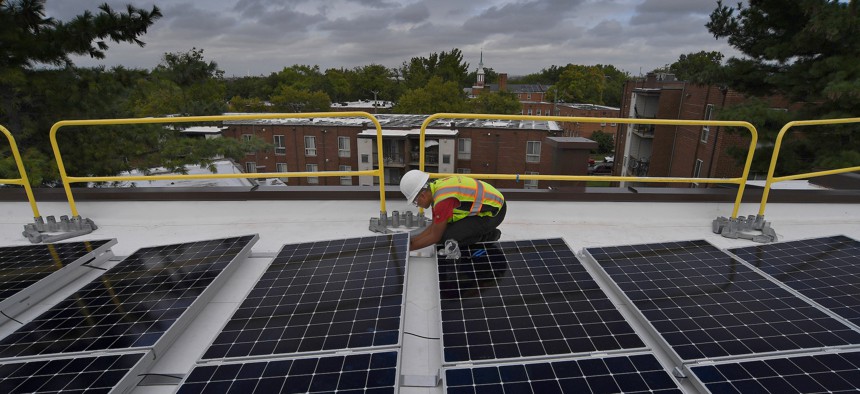Billions in Loans and Grants to Make Multifamily Homes Energy Efficient

Naomi Hawk works on a job site installing solar panels on the roof of an apartment complex in Washington D.C. in 2019. Michael S. Williamson/The Washington Post via Getty Images
Incentives for green retrofitting often target individual homeowners. A new federal program will fund energy-efficient and climate-resilient upgrades in multifamily homes, which can improve the quality of life of historically underserved populations.
The Biden administration recently announced the availability of more than $837 million in grants and loan subsidy funding to finance energy-efficient and climate-resilient upgrades in low-income multifamily housing. The program will also distribute up to $4 billion in loans and aims to help families in underserved communities that are typically last to see green technology installed in their homes, leaving them with higher energy bills and harmful health effects.
The U.S. Department of Housing and Urban Development announced the program to support green retrofitting initiatives in multifamily homes last week. Created under the Inflation Reduction Act, the Green and Resilient Retrofit Program (GRRP) will help building owners finance projects like the installation of electric heat pumps, solar panels and energy-efficient windows.
These upgrades, which will reduce harmful greenhouse gasses and save energy and water, can help residents save money on energy costs and improve their health, according to Sara McTarnaghan, a senior research associate for the Urban Institute. Swapping gas stoves for electric ones, for example, can improve indoor air quality.
Electric heat pumps, which use electricity to transfer heat either into or out of a building, have gained popularity in the last several years, especially as extreme heat sweeps the country each year. Some communities are already turning to the devices as a public health measure. For example, after a 2021 heat wave killed at least 100 people in Oregon, state lawmakers approved millions of dollars to help landlords pay for heat pumps.
The green retrofitting is also expected to improve residents’ quality of life by making buildings safer through upgrades like fire-resistant roof installations. Making the buildings more resilient to fires, floods and other extreme weather is critical as the climate warms, and the program helps to include everyone in the country’s green transition regardless of income, McTarnaghan said.
The initiative aligns with the Biden administration’s environmental justice and climate executive orders, as residents in HUD-assisted housing are more likely to be people of color, people with disabilities or similarly underserved demographics.
“Putting this type of investment into that population is critically important,” McTarnaghan said.
The program is the first from HUD “that simultaneously invests in energy and water efficiency, greenhouse gas emissions reductions, clean energy generation and climate resilience strategies in multifamily housing,” a department press release notes. The initiative is designed to support property owners with “varying levels of expertise with green retrofits”, and the agency expects the program will support hundreds of projects.
Many incentives and initiatives for solar and other weatherization programs target individual homeowners, McTaraghan said, but there’s long been a gap when it comes to multifamily housing, especially affordable multifamily properties.
“HUD … is recognizing the need to step in and play a role in supporting funding as well as technical assistance,” she said.
But the program only supports a small fraction of the redevelopments necessary to ensure all residents have a safe, resilient and efficient place to call home.
This alone is not going to cover all of the buildings or their complete retrofitting, McTarnaghan said, and it will be important to identify other sources to supplement the GRRP funds, whether it’s from other parts of the landmark climate law or recovery funds that arrive in the wake of disasters.
The Inflation Reduction Act also provides about $42 million to collect and assess energy and water usage in HUD-assisted multifamily housing. That information will be used to identify the best strategies for reducing use and cutting greenhouse gas emissions.
HUD will host a webinar next Tuesday to share more program details.
Molly Bolan is the assistant editor for Route Fifty.
NEXT STORY: Wildlife management migrates to the cloud






